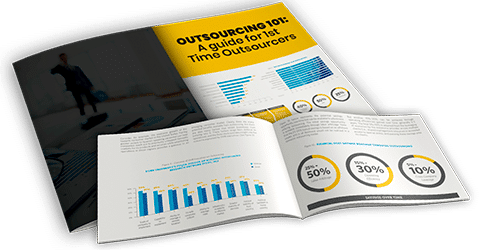Outsourcing has been a growing business trend that has transformed our local economies into global ones since the 1990s. Through outsourcing services, businesses around the world can now establish professional services markets in far-off locations while lowering costs, improving processing efficiencies, and gaining a greater focus on strategic activities back home.
Initially, it appeared as though only the big international players could reap the benefits outsourcers provided, but recent changes in the global landscape have opened the door for smaller businesses to enter the picture. Now, smaller enterprises are searching for the right outsourcing opportunities for their business, yet many may not know where to start. With this challenge in mind, Auxis has created Outsourcing 101: A Game Plan for First-Time Outsourcers.
Our guide begins by unpacking the differences between outsourcing and Shared Services, two prevalent offshore service delivery models that are oftentimes incorrectly thought of as the same business practice. While Shared Services are services provided to business unit(s) by a separate entity that remains a part of the overall organization, outsourcing actually involves an external third party providing services to organizations that were previously performed by internal staff.
The goal of both shared services and outsourcing is to reduce operating costs through labor arbitrage and/or greater economies of scale amongst the labor force. Through outsourcing, however, businesses can gain access to tools from third-party outsourcers that drive automation and process standardization, which in turn improves operational performance. Additionally, due to the nature of the third-party relationship in outsourcing, companies are also able to establish a higher level of operational visibility and accountability to contractual service levels and performance metrics.
When evaluating these benefits, it’s no wonder that companies are taking a keen interest in learning more about outsourcing services, but there are several factors to consider before diving into the world of outsourcing headfirst. For this reason, our guide also explores the 4 key questions business executives should ask themselves when choosing the right outsourcing partner to ensure positive results with these services:
1. Is Outsourcing Right For My Business?
The first step of your outsourcing journey is to consider whether or not you really want to outsource services and what this process implies for your business. Learn about several factors that can influence your decision, which may vary depending on your specific needs and goals, as well as the current state of your business’s operations. For example, sometimes the decision can be cost-based, and sometimes it can be driven by performance improvement. Either way, you need to think of outsourcing as a way to meet well-defined expectations and outcomes that are beneficial to your business.
2. What Functions Should I Consider Outsourcing?
Identify the main activities most businesses choose to move offshore, a decision that often improves their activities back home. Thoughtfully examine your own business to pinpoint the issues that could be addressed practically and realistically through an outsourcing service provider. Keep in mind a brand new team in a remote location will now be handling these transferred issues, so ensuring they can efficiently handle them as an extension of your own team is essential. Figuring out this crucial information about your current activities ensures their successful migration.
3. Which Location Should I Outsource To?
Outsourcing firms can provide countless locations to choose from. Services can be migrated off-shore to cities in Asia, Eastern and Western Europe, Africa, and/or Latin America. However, factors such as time zones, wage comparisons, and cultural compatibility must be carefully assessed before making the big move. Economics and geography are always going to be the top factors in answering the location question.
4. How Do I Get Started?
Once you have made the decision to outsource, you can follow our 4 fundamental steps to finalize your decision on what to outsource, where to do it, and with whom. Learn how to analyze, design, implement and optimize your process to achieve the best results.
If you would like to learn how to put this game plan into action, please click below to download our complete guide, Outsourcing 101: A Game Plan for First-Time Outsourcers.


